Reliability Tests
The identification reliability is important for large-scale systems. MegaMatcher SDK includes a fused algorithm for fast and reliable identification using several biometric records taken from the same person.
As we do not have any single database with all supported biometric modalities, separate tests with selected modalities were performed for the MegaMatcher biometric engines to demonstrate their reliability and performance with single biometric modalities and combinations of several modalities:
Fingerprint, face and iris matching engines tests
The tests with MegaMatcher biometric fingerprint, face and iris matching engines and fused template matching algorithm were performed using Neurotechnology internal multi-biometric database:
- The database had 7,500 sets of biometric records; each set contained 1 face, 2 irises and 10 fingerprints representing a unique person.
- 1,500 unique persons were represented in the database.
- 5 capture sessions were performed for each person.
The tests were performed with these biometric template types:
- 1 fingerprint record extracted from left index fingerprint image.
- 1 face record.
- 1 iris record extracted from left eye image.
- 2 fingerprint records extracted from same person's left and right index fingerprint images.
- 2 iris records extracted from same person's different eye images.
- 1 fingerprint + 1 face records – left index fingerprint and face taken from the same person.
- 1 face + 1 iris records – left iris and face taken from the same person.
- 1 fingerprint + 1 iris records – left index fingerprint and left iris taken from the same person.
- 1 fingerprint + 1 face + 1 iris records – left index fingerprint, left iris and face taken from the same person.
The biometric engines had these parameters set:
- ±90 degrees fingerprint rotation tolerance value was used for template matching;
- ±15 degrees iris rotation tolerance value was used for template matching.
Two tests were performed with each template type:
- Test 1 maximized matching accuracy. MegaMatcher 13.1 fused algorithm reliability in this test is shown as blue curves on the ROC charts.
- Test 2 maximized matching speed. MegaMatcher 13.1 fused algorithm reliability in this test is shown as red curves on the ROC charts.
The tests with templates. which contained 1 fingerprint + 1 face + 1 iris records, resulted with 0 % FRR for all FAR values
Receiver operation characteristic (ROC) curves are usually used to demonstrate the recognition quality of an algorithm. ROC curves show the dependence of false rejection rate (FRR) on the false acceptance rate (FAR).
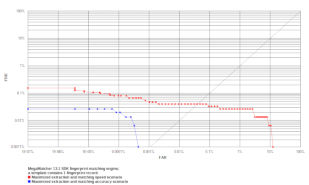
Click to zoom
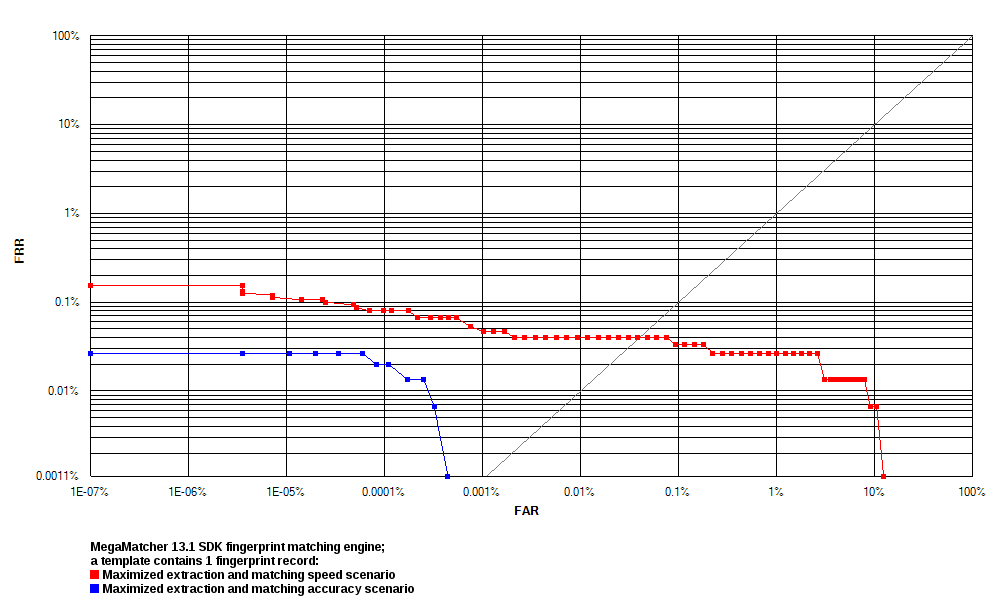
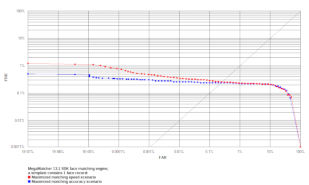
Click to zoom
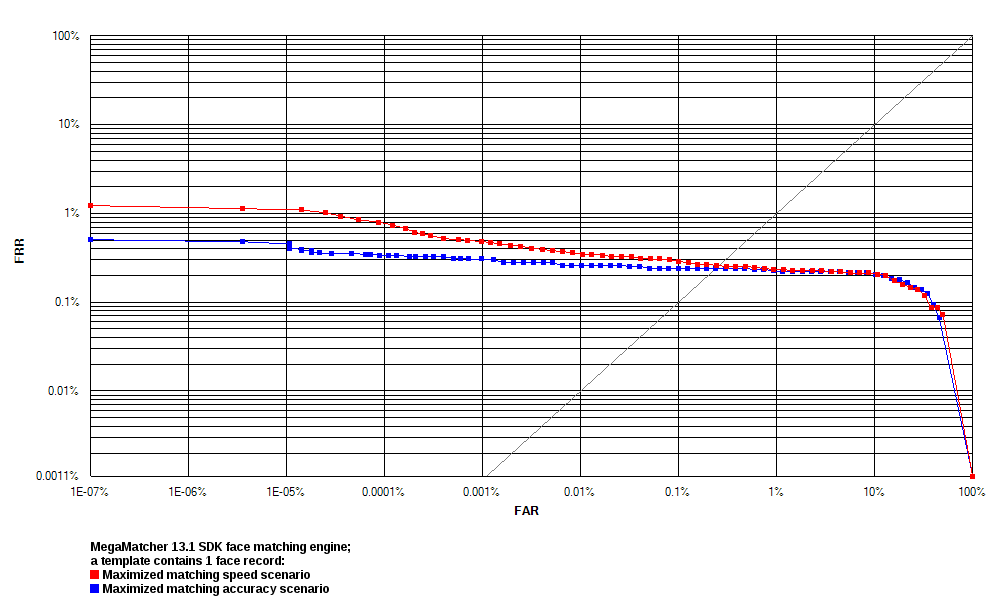
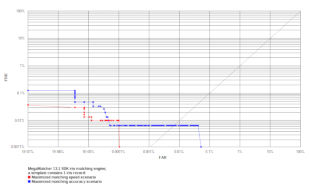
Click to zoom
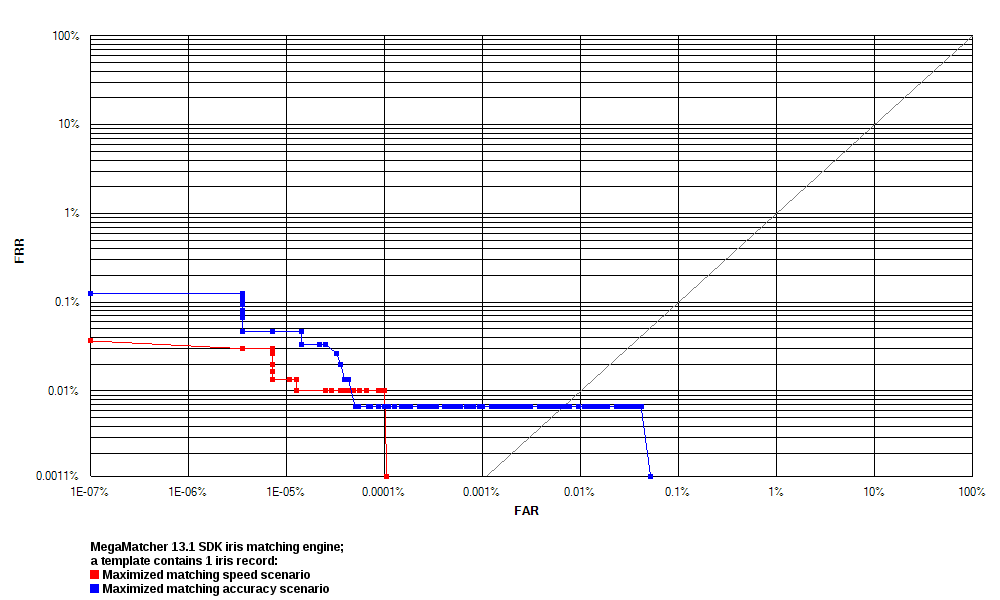
Note that the tests with these biometric template types resulted with 0 % FRR for all FAR values, thus their charts are not shown:
- 2 fingerprint records
- 2 iris records
- 1 fingerprint + 1 face records
- 1 fingerprint + 1 iris records
- 1 face + 1 iris records
- 1 fingerprint + 1 face + 1 iris records
| MegaMatcher 13.1 template matching engines reliability testing results | ||||||
|---|---|---|---|---|---|---|
| A template contains these biometric records | FRR at 0.001 % FAR |
FRR at 0.0001 % FAR |
||||
| Test 1 | Test 2 | Test 1 | Test 2 | |||
| 1 fingerprint | 0.0000 % | 0.0533 % | 0.0200 % | 0.0800 % | ||
| 1 face | 0.3000 % | 0.4800 % | 0.3200 % | 0.8000 % | ||
| 1 iris | 0.0133 % | 0.0133 % | 0.0133 % | 0.0200 % | ||
| 2 fingerprints | 0.0000 % | 0.0000 % | 0.0000 % | 0.0000 % | ||
| 2 irises | 0.0000 % | 0.0000 % | 0.0000 % | 0.0000 % | ||
| 1 fingerprint + 1 face | 0.0000 % | 0.0000 % | 0.0000 % | 0.0000 % | ||
| 1 fingerprint + 1 iris | 0.0000 % | 0.0000 % | 0.0000 % | 0.0000 % | ||
| 1 face + 1 iris | 0.0000 % | 0.0000 % | 0.0000 % | 0.0000 % | ||
| 1 fingerprint + 1 face + 1 iris | 0.0000 % | 0.0000 % | 0.0000 % | 0.0000 % | ||
These tests show that a large-scale automated biometric identification system based on MegaMatcher provides high identification reliability when using fingerprints, using fused same-biometric (different fingerprints or irises from the same person) matching significantly reduces FRR, and using multi-biometric identification results in a significant reliability increase.
Voiceprint and face matching engines tests
The tests with MegaMatcher biometric face and voiceprint matching engines, and the fused template matching algorithm were performed using face images and voice samples from the XM2VTS Database:
- 295 unique persons were represented in the database.
- 8 capture sessions were performed for each person.
- The phrase 1 from the database was used for the testing, meaning that the same fixed phrase was used for all subjects.
The tests were performed with these biometric template types:
- 1 face record.
- 1 voiceprint record.
- 1 voiceprint + 1 face records taken from the same person.
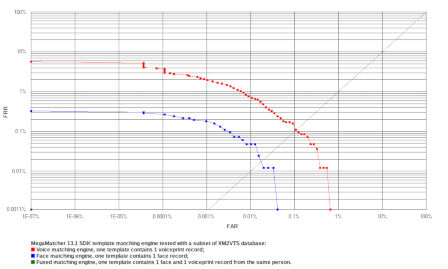
Click to zoom

Receiver operation characteristic (ROC) curves are usually used to demonstrate the recognition quality of an algorithm. ROC curves show the dependence of false rejection rate (FRR) on the false acceptance rate (FAR).
| MegaMatcher 13.1 face, voiceprint and fused template matching engines tests | |||
|---|---|---|---|
| 1 face in a template |
1 voiceprint in a template |
1 voiceprint + 1 face in a template |
|
| FRR at 0.001 % FAR | 0.1818 % | 2.0840 % | 0.0000 % |
| FRR at 0.0001 % FAR | 0.2908 % | 3.8770 % | 0.0000 % |
Palm print engine tests
The MegaMatcher palm print template matching algorithm reliability tests were performed using internal palm print images database. The database contained 1,993 images of right hand full palms and 1,996 images of left hand full palms. The database represented 1,000 unique persons.
Receiver operation characteristic (ROC) curves are usually used to demonstrate the recognition quality of an algorithm. ROC curves show the dependence of false rejection rate (FRR) on the false acceptance rate (FAR). The chart with ROC curves for the MegaMatcher palm print template matching algorithm are available on the right.

